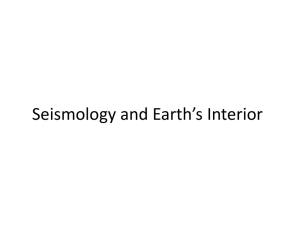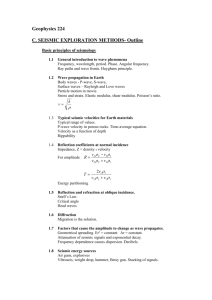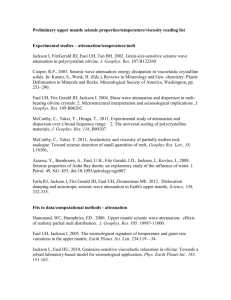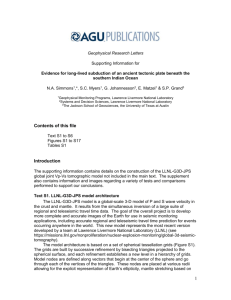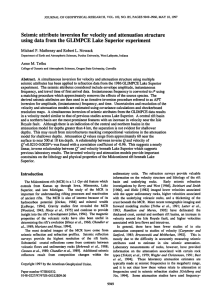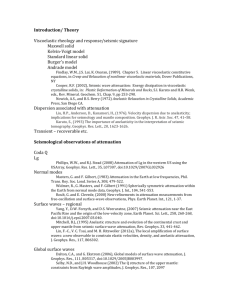Finite-Frequency Tomography of D`` Shear Velocity Heterogeneity
advertisement
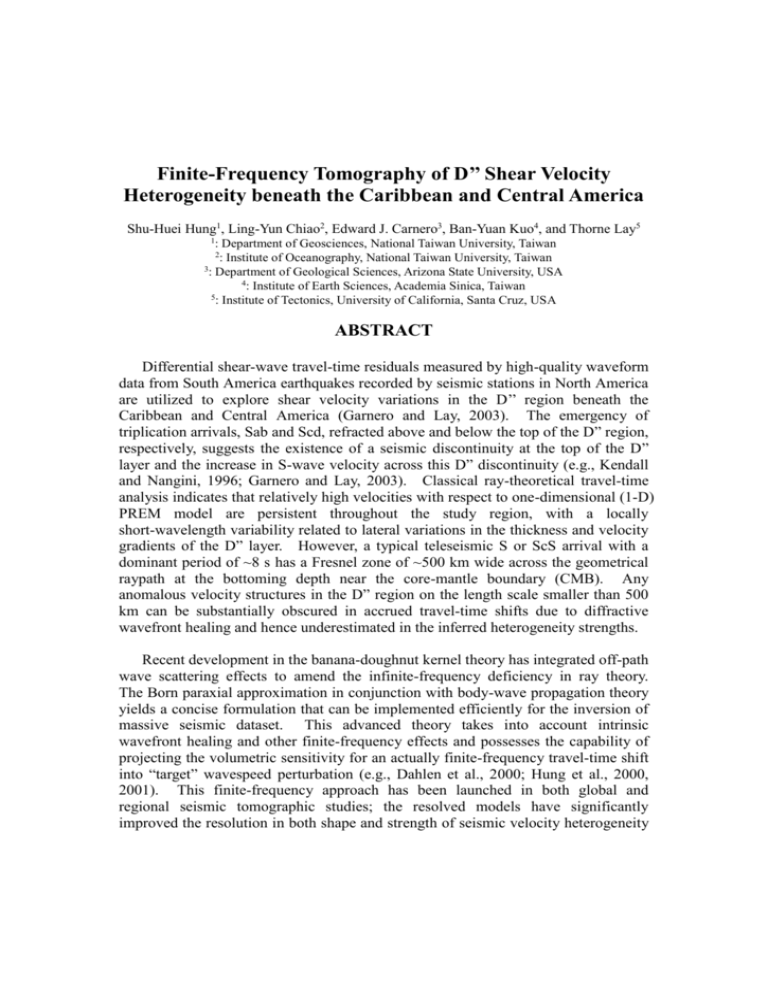
Finite-Frequency Tomography of D’’ Shear Velocity Heterogeneity beneath the Caribbean and Central America Shu-Huei Hung1, Ling-Yun Chiao2, Edward J. Carnero3, Ban-Yuan Kuo4, and Thorne Lay5 1 : Department of Geosciences, National Taiwan University, Taiwan 2 : Institute of Oceanography, National Taiwan University, Taiwan 3 : Department of Geological Sciences, Arizona State University, USA 4 : Institute of Earth Sciences, Academia Sinica, Taiwan 5 : Institute of Tectonics, University of California, Santa Cruz, USA ABSTRACT Differential shear-wave travel-time residuals measured by high-quality waveform data from South America earthquakes recorded by seismic stations in North America are utilized to explore shear velocity variations in the D’’ region beneath the Caribbean and Central America (Garnero and Lay, 2003). The emergency of triplication arrivals, Sab and Scd, refracted above and below the top of the D” region, respectively, suggests the existence of a seismic discontinuity at the top of the D” layer and the increase in S-wave velocity across this D” discontinuity (e.g., Kendall and Nangini, 1996; Garnero and Lay, 2003). Classical ray-theoretical travel-time analysis indicates that relatively high velocities with respect to one-dimensional (1-D) PREM model are persistent throughout the study region, with a locally short-wavelength variability related to lateral variations in the thickness and velocity gradients of the D” layer. However, a typical teleseismic S or ScS arrival with a dominant period of ~8 s has a Fresnel zone of ~500 km wide across the geometrical raypath at the bottoming depth near the core-mantle boundary (CMB). Any anomalous velocity structures in the D” region on the length scale smaller than 500 km can be substantially obscured in accrued travel-time shifts due to diffractive wavefront healing and hence underestimated in the inferred heterogeneity strengths. Recent development in the banana-doughnut kernel theory has integrated off-path wave scattering effects to amend the infinite-frequency deficiency in ray theory. The Born paraxial approximation in conjunction with body-wave propagation theory yields a concise formulation that can be implemented efficiently for the inversion of massive seismic dataset. This advanced theory takes into account intrinsic wavefront healing and other finite-frequency effects and possesses the capability of projecting the volumetric sensitivity for an actually finite-frequency travel-time shift into “target” wavespeed perturbation (e.g., Dahlen et al., 2000; Hung et al., 2000, 2001). This finite-frequency approach has been launched in both global and regional seismic tomographic studies; the resolved models have significantly improved the resolution in both shape and strength of seismic velocity heterogeneity (Montelli et al., 2004a, b; Hung et al., 2003). To better understand the thermal, chemical and geodynamical causes for the complicated environment in the D” region, we employ finite-frequency tomography to image fine-scale shear velocity heterogeneity in the lowermost 500-km mantle beneath the Central America using differential ScS-S, S(Sdiff)-SKS, Scd-S, and ScS-Scd travel-time residuals as constraints. Prior to the tomographic inversion all the differential times are corrected for contributions from aspherical mantle structure based on high-resolution global models (Ritsema and Van Heist, 2000; Megnin and Romanowicz, 2000; Grand, 2002). The 3-D banana-doughnut-shaped kernel for individual pair of differential travel-time measurement is constructed in a radially-symmetric model SKNA1 which allows a seismic discontinuity at the depth of 2636 km and a positive velocity gradient on the top of the D” layer. Different from the intuitive 1-D ray interpretation in which a ScS phase essentially samples the velocity structure at the reflection point right on the CMB and a Scd wave is most sensitive to the top D” layer at the bottoming depth of the raypath, alternatively the regions besieged by finite-frequency ScS and Scd arrivals are interchanged because of their widespread off-path sensitivity. We will present robust D” features beneath the Caribbean and Central America derived from the kernel-based tomographic model and discuss its implication on the nature of the D” layer in the transition from the liquid iron-rich core to the solid silicate mantle. REFERENCES Dahlen, F.A., S.-H. Hung, and G. Nolet, Fr'echet kernels for finite- frequency traveltimes-- I. Theory, Geophys. J. Int., 141, 157-174, 2000. Garnero, E.J., and T. Lay, D” shear velocity heterogeneity, anisotropy and discontinuity structure beneath the Caribbean and Central America, Phys. Earth. Planet. Int., 140, 219-242, 2003. Grand, S.P., Mantle shear-wave tomography and the fate of subducted slabs, Phil. Trans. R. Soc. Lond. A, 360, 2475-2491, 2002. Hung, S.-H., F.A. Dahlen, and G. Nolet, Fr'echet kernels for finite- frequency traveltimes-- II. Examples, Geophys. J. Int., 141, 175-203, 2000. Hung, S.-H., F.A. Dahlen, and G. Nolet, Wavefront healing: a banana-doughnut perspective, Geophys. J. Int., 146, 289-312, 2001. Hung, S.-H., Y. Shen, and L.-Y. Chiao, Imaging seismic velocity structure beneath the Iceland hotspot: A finite-frequency approach, sumitted to J. Geophys. Res., 2003. Kendall, J-M., and C. Nangini, Lateral variations in D” below the Caribbean, Geophys. Res. Lett., 23, 399-402, 1996. Megnin, C., and B. Romanowicz, The three-dimensional shear velocity structure of the mantle from the inversion of body, surface, and higher-mode waveforms, Geophys. J. Int., 143, 709-728, 2000. Ritsema, J., Van Heijst, H.J., Seismic imaging of structural heterogeneity in Earth’s mantle: evidence for large-scale mantle flow, Science progress, 83, 1925, 2000.

